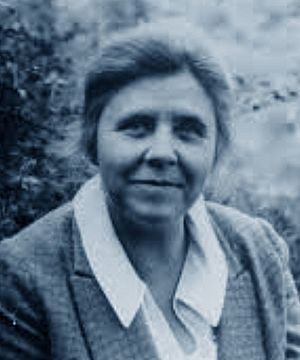Anna Johnson Pell Wheeler facts for kids
Quick facts for kids
Anna Johnson Pell Wheeler
|
|
|---|---|
 |
|
| Born |
Anna Johnson
May 5, 1883 Calliope, Iowa, U.S.
|
| Died | March 26, 1966 (aged 82) Bryn Mawr, Pennsylvania, U.S.
|
| Spouse(s) |
Alexander Pell
(m. 1907; died 1921)Arthur Wheeler
(m. 1925; died 1932) |
| Nationality | American |
| Alma mater |
|
| Known for | Early work on linear algebra in infinite dimensions |
| Scientific career | |
| Fields | Mathematics |
| Institutions |
|
| Theses |
|
| Doctoral advisors |
|
| Doctoral students | |
| Other notable students | |
Anna Johnson Pell Wheeler (born Johnson; May 5, 1883 – March 26, 1966) was an important American mathematician. She is known for her early work on a type of math called linear algebra, especially when dealing with very large, "infinite" spaces. This work later became a key part of a field called functional analysis.
Contents
Biography
Early Life and Education
Anna Johnson was born on May 5, 1883, in Calliope, Iowa. Her parents were immigrants from Sweden. Her father, Andrew Gustav Johnson, sold furniture. Her mother, Amelia, took care of their home. Anna had two older siblings. When she was nine, her family moved to Akron, Iowa, and she went to a private school.
In 1903, Anna graduated from the University of South Dakota. She then started her advanced studies at the University of Iowa. In 1904, she earned a master's degree for her paper titled The extension of Galois theory to linear differential equations. Just one year later, she earned a second master's degree from Radcliffe College. There, she learned from famous mathematicians like Maxime Bôcher.
Studies in Germany and Marriage
In 1905, Anna received a special scholarship called the Alice Freeman Palmer Fellowship. This allowed her to spend a year studying at the University of Göttingen in Germany. She learned from brilliant minds such as David Hilbert, Felix Klein, and Hermann Minkowski.
While she was working on her doctorate, her relationship with Alexander Pell grew stronger. He was a former professor from the University of South Dakota. Alexander traveled to Göttingen, and they got married in July 1907. Alexander had a complicated past, and this trip was risky for him.
Return to the U.S. and Career Challenges
After their wedding, the Pells returned to Vermillion, South Dakota. Anna taught classes on functions and differential equations. By 1908, she was back in Göttingen to finish her doctorate. However, a disagreement with David Hilbert made it impossible to complete her degree there.
She then moved with her husband to Chicago. There, she worked with mathematician E. H. Moore to finish her doctoral paper. It was titled Biorthogonal Systems of Functions with Applications to the Theory of Integral Equations. She earned her Ph.D. in 1909.
After getting her Ph.D., Anna looked for a teaching job. But she found it difficult because many universities preferred men for teaching positions, even if they were less qualified. She wrote to a friend about this challenge.
Teaching and Research
In 1911, her husband, Alexander, had a stroke. Anna taught his classes at the Armout Institute for the rest of the semester. She then accepted a job at Mount Holyoke College, where she taught for seven years.
In 1917, her last year at Mount Holyoke College, she published an important paper with R. L. Gordon. In this paper, they solved a math problem that had puzzled other mathematicians for many years. This work was forgotten for almost a century before being rediscovered.
Bryn Mawr College and Later Life
In 1918, Anna became an associate professor at Bryn Mawr College in Pennsylvania. Three years later, she became the head of the mathematics department at Bryn Mawr. In 1925, she became a full professor.
That same year, she married a colleague named Arthur Wheeler. He soon moved to Princeton University. Anna moved with him, traveling back and forth to Bryn Mawr to teach part-time. She also became active in Princeton's math community. In 1927, she made history as the first woman to give a lecture at the American Mathematical Society Colloquium.
After Arthur Wheeler died in 1932, Anna returned to Bryn Mawr and taught full-time. She played a big part in bringing the famous German mathematician Emmy Noether to Bryn Mawr in 1933. Emmy Noether had been forced to leave her job in Germany by the Nazi government. Anna and Emmy worked happily together for two years until Emmy passed away suddenly in 1935.
Anna Johnson Pell Wheeler continued teaching at Bryn Mawr until she retired in 1948. She passed away in 1966 after having a stroke. Some of her notable students included Dorothy Maharam and Marion Cameron Gray.
See also
 In Spanish: Anna Johnson Pell Wheeler para niños
In Spanish: Anna Johnson Pell Wheeler para niños

